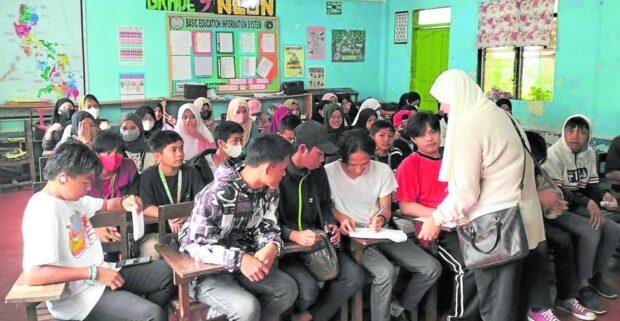
PACKED CLASSROOM | Classes begin with packed classrooms across the Bangsamoro region, such as in this high school in Maguindanao del Norte, in this photo taken on Aug. 29. (MBHTE-BARMM PHOTO)
COTABATO CITY, Maguindanao del Norte, Philippines — The education ministry of the Bangsamoro Autonomous Region in Muslim Mindanao (BARMM) reported that 1,258,253 students have enrolled in various public schools, including in government-run “madaris” (Islamic schools) and community learning centers, for the new school year that opened in August.
Minister Mohagher Iqbal of the Bangsamoro Ministry of Basic, Higher and Technical Education (MBHTE) described the high number of students as an “enrollment milestone” since there were 219,591 more students this school year, or 17 percent more than the 1,038,662 enrolled last year.
This diverse enrollment includes 1,119,391 students in basic education, 63,565 in secondary education, 55,172 in madaris and 20,195 in higher education, spread across 4,635 schools, including community learning centers, “Abot-Kaalaman sa Pamilyang (Akap)-Bangsamoro” learning centers, madrasahs and training centers. Akap is a program that brings class instruction to remote areas where there are no nearby schools.
The Bangsamoro region has a total population of 4,404,288 as of the 2020 census, with an annual population growth of 3.26 percent, according to the Philippine Statistics Authority.
The 2020 population count comprised of the provinces of Basilan, with 426,207 persons; Lanao del Sur, with 1,195,518; the then still undivided Maguindanao, with 1,342,179; Sulu with 1,000,108; and Tawi-Tawi, with 440,276; and the regional government center, Cotabato City, with 325,079.Iqbal said this enrollment rate “underscored MBHTE’s commitment to providing access and quality education in the region” and the education ministry’s motto of “No child should be left behind.”
‘Fill up classrooms’
“Our mission is clear—we will continue enrolling children until every classroom is filled with eager learners,” Iqbal said in a statement on Monday.
Prior to the listup, MBHTE had actively engaged the region’s communities and parents through awareness campaigns, community outreach programs, and other innovative strategies, aiming to haul children to schools.
Iqbal said MBHTE is also implementing the Matatag curriculum of the Department of Education (DepEd) amid challenges of equipping teachers and schools with needed educational technologies, especially in remote and underserved areas.
The Matatag curriculum aims to streamline the current K-12 curriculum to allow learners to focus on the development of foundational skills, such as literacy, numeracy, and socioemotional skills, for those in Kindergarten up to Grade 3.
Matatag stands for “make the curriculum relevant to produce job-ready, active and responsible citizens; take steps to accelerate the delivery of basic education services and provision facilities; take good care of learners by promoting learner well-being, inclusiveness learning, and positive learning environment; and, give support for teachers to teach better.”
Partners
The Matatag curriculum will be implemented in the BARMM through partnerships with the United Nations International Children’s Emergency Fund (Unicef), Iqbal said.
He said early childhood education is also a priority in the BARMM, aiming to provide a seamless educational journey for young learners by, among others, allowing greater parental involvement in their children’s education and enhancing coordination among school divisions, local governments, and local school boards.
Since the region is prone to calamities that affect the holding of classes, Iqbal said they were moving to create climate-resilient and eco-friendly schools and classrooms that can withstand extreme weather.
In a statement, Unicef commended DepEd and MBHTE for getting children back into schools after the COVID-19 pandemic and for launching the new K-10 curriculum focused on foundational skills.
The UN children’s agency encouraged officials to prioritize early learning, strengthen parental engagement and intensify local actions tied to the national Matatag agenda.
“The learning crisis affects vulnerable children the most and is a major driver of intergenerational poverty and inequality. The futures of millions of children in the Philippines hang in the balance,” said Unicef Philippines representative Oyunsaikhan Dendevnorov.
In the Philippines, around 78 percent of children 3 to 4 years old are not attending daycare while 28 percent of 5-year-olds were not enrolled in Kindergarten, Unicef noted.
It added that the numbers are more dismal in regions, such as the BARMM, where 90 percent of children are not in daycare and 35 percent are not in Kindergarten.
“Quality preprimary education is the foundation of a child’s journey. Every stage of education that follows relies on its success,” the UN children’s agency said.